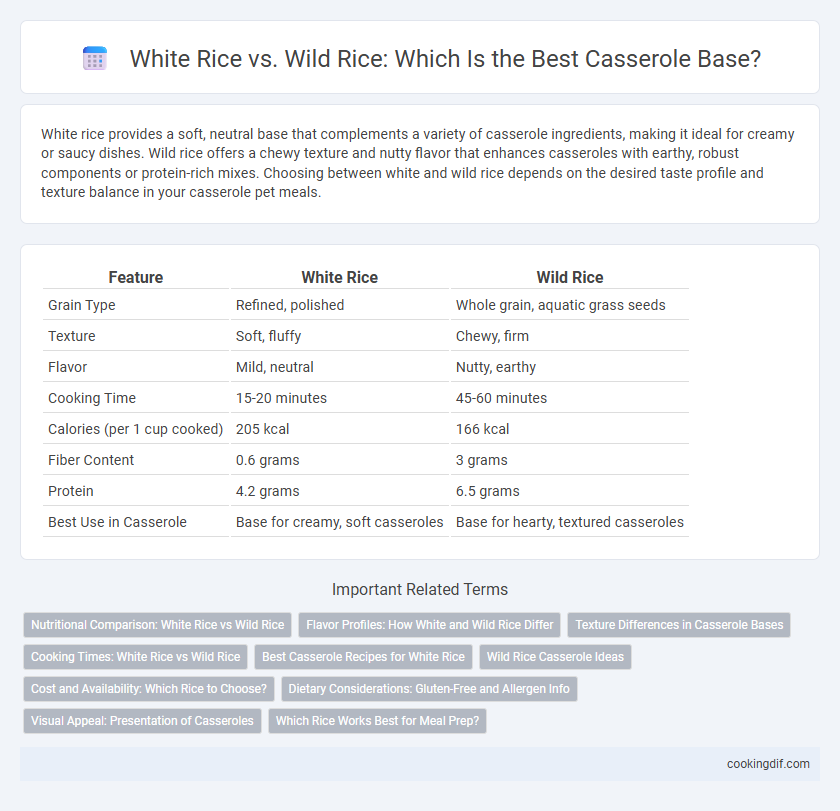White rice provides a soft, neutral base that complements a variety of casserole ingredients, making it ideal for creamy or saucy dishes. Wild rice offers a chewy texture and nutty flavor that enhances casseroles with earthy, robust components or protein-rich mixes. Choosing between white and wild rice depends on the desired taste profile and texture balance in your casserole pet meals.
Table of Comparison
| Feature | White Rice | Wild Rice |
|---|---|---|
| Grain Type | Refined, polished | Whole grain, aquatic grass seeds |
| Texture | Soft, fluffy | Chewy, firm |
| Flavor | Mild, neutral | Nutty, earthy |
| Cooking Time | 15-20 minutes | 45-60 minutes |
| Calories (per 1 cup cooked) | 205 kcal | 166 kcal |
| Fiber Content | 0.6 grams | 3 grams |
| Protein | 4.2 grams | 6.5 grams |
| Best Use in Casserole | Base for creamy, soft casseroles | Base for hearty, textured casseroles |
Nutritional Comparison: White Rice vs Wild Rice
Wild rice contains significantly higher protein and fiber levels compared to white rice, making it a more nutrient-dense option for casseroles. White rice offers a higher glycemic index, which can lead to quicker spikes in blood sugar levels, whereas wild rice has a lower glycemic response, supporting better blood sugar control. Additionally, wild rice provides more antioxidants, vitamins, and minerals such as magnesium, zinc, and phosphorus than white rice, enhancing the overall nutritional profile of a casserole.
Flavor Profiles: How White and Wild Rice Differ
White rice offers a mild, slightly sweet flavor with a soft, fluffy texture that absorbs sauces well, making it versatile for casserole bases. Wild rice provides a nutty, earthy taste with a chewy texture that adds depth and a distinctive bite to casseroles. Choosing between white and wild rice impacts the overall flavor profile, with wild rice enhancing heartiness and complexity while white rice maintains subtlety and smoothness.
Texture Differences in Casserole Bases
White rice offers a soft, fluffy texture that absorbs flavors well, creating a creamy casserole base. Wild rice provides a chewy, nutty bite with a firmer consistency that adds contrast and depth to the dish. Choosing between these rice types depends on whether a smooth, tender foundation or a hearty, textured complement is preferred in the casserole.
Cooking Times: White Rice vs Wild Rice
White rice typically cooks in 15-20 minutes, making it a quick and efficient base for casseroles. Wild rice requires a longer cooking time, around 45-60 minutes, which can impact overall preparation scheduling. Choosing between white and wild rice depends on desired texture and time constraints in casserole recipes.
Best Casserole Recipes for White Rice
White rice offers a soft texture and mild flavor that easily absorbs seasonings and sauces, making it ideal as a base for casseroles like chicken and broccoli or creamy mushroom dishes. Its quick cooking time enhances convenience without compromising on creating a comforting, cohesive dish. Compared to wild rice, white rice provides a tender bite that blends seamlessly with cheeses and vegetables, elevating the classic casserole experience.
Wild Rice Casserole Ideas
Wild rice offers a nutty flavor and chewy texture that enhances casseroles, making it a nutritious alternative to traditional white rice. Rich in antioxidants, fiber, and essential minerals, wild rice complements ingredients like mushrooms, cranberries, and pecans in savory and sweet casserole recipes. Incorporating wild rice into casseroles provides a hearty base that balances protein-rich meats or creamy vegetables, elevating both taste and nutritional value.
Cost and Availability: Which Rice to Choose?
White rice offers a more cost-effective and widely available option for casserole bases compared to wild rice, which tends to be pricier and less common in grocery stores. The affordability of white rice makes it ideal for budget-conscious cooking while maintaining easy access. Wild rice provides a unique texture and flavor but can increase overall meal cost and may require special sourcing.
Dietary Considerations: Gluten-Free and Allergen Info
White rice and wild rice both serve as gluten-free bases ideal for casseroles, making them safe for individuals with gluten sensitivities or celiac disease. White rice is a hypoallergenic option with a mild flavor and soft texture, ideal for those with sensitive digestive systems or food allergies. Wild rice, while also gluten-free, contains higher fiber and protein, providing added nutritional benefits without triggering common allergens.
Visual Appeal: Presentation of Casseroles
White rice offers a clean, uniform look that enhances the visual appeal of casseroles with its bright, neutral color and fluffy texture. Wild rice provides a contrasting dark, speckled appearance that adds depth and sophistication to casserole presentation. Combining both can create an eye-catching mosaic effect, elevating the dish's aesthetic appeal while highlighting different textures.
Which Rice Works Best for Meal Prep?
White rice offers a soft texture and neutral flavor that absorbs casserole sauces well, making it ideal for consistent meal prep with easy reheating. Wild rice provides a nuttier taste and chewier texture, adding complexity and higher fiber content but may require longer cooking times and slightly more attention in bulk preparation. For efficient meal prep, white rice is typically preferred due to its quick cooking and versatility in casseroles.
White rice vs wild rice for base Infographic

 cookingdif.com
cookingdif.com